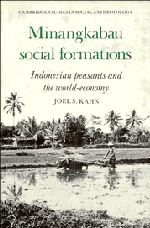Book contents
- Frontmatter
- Contents
- Lists of maps, figures and tables
- Preface
- Map
- 1 Introduction
- 2 The internal and the external in a Minangkabau village: an introduction to the world of the concrete
- 3 Adat, kinship and marriage: the constitution of the subsistence community
- 4 Agriculture and subsistence: the reproduction of the subsistence community
- 5 Commodity production in the village economy: the case of blacksmithing
- 6 Occupation, class and the peasant economy
- 7 The structure of petty commodity production
- 8 Mercantilism and the evolution of ‘traditional’ society
- 9 The emergence of petty commodity production
- 10 Conclusions: The concept of a neo-colonial social formation
- Bibliography
- Glossary of Minangkabau terms
- Index
- CAMBRIDGE STUDIES IN SOCIAL ANTHROPOLOGY
2 - The internal and the external in a Minangkabau village: an introduction to the world of the concrete
Published online by Cambridge University Press: 29 September 2009
- Frontmatter
- Contents
- Lists of maps, figures and tables
- Preface
- Map
- 1 Introduction
- 2 The internal and the external in a Minangkabau village: an introduction to the world of the concrete
- 3 Adat, kinship and marriage: the constitution of the subsistence community
- 4 Agriculture and subsistence: the reproduction of the subsistence community
- 5 Commodity production in the village economy: the case of blacksmithing
- 6 Occupation, class and the peasant economy
- 7 The structure of petty commodity production
- 8 Mercantilism and the evolution of ‘traditional’ society
- 9 The emergence of petty commodity production
- 10 Conclusions: The concept of a neo-colonial social formation
- Bibliography
- Glossary of Minangkabau terms
- Index
- CAMBRIDGE STUDIES IN SOCIAL ANTHROPOLOGY
Summary
The nagari, or village, of Sungai Puar is located in the Agam district in the cultural heartland of Minangkabau territory near Bukit Tinggi, the district capital. The Agam plateau is one of the larger of the cultivable areas in the highlands about 1,000 metres above sea level and located at the base of the three mountains of Marapi, Singgalang and Sago, the peaks of which tower a further 2,000 metres above the valley floor. Sungai Puar rests at the foot of Mount Marapi, a tame but still active volcano whose lower slopes are sufficiently gradual to allow villagers to cultivate irrigated rice on terraced fields.
Agam district, with a population of some 340,000 in 1970, is administered from the town of Bukit Tinggi, which grew up on the site of the nineteenth-century Dutch Fort de Kock. Bukit Tinggi is the seat of the regional assembly, and the district is administered by an executive group and a single appointed head, the Bupati, whose appointment is subject to the approval of the provincial government (Said, 1970).
The provincial capital, Padang, lies on the west coast, about 90 kilometres to the south-west of Bukit Tinggi. Access is by either the main Padang–Medan road, which passes through the district capital, or a narrow-gauge railway. While the train is slow and the service relatively infrequent, there is a heavy lorry and bus traffic between the two towns.
The district of Agam is made up of 10 subdistricts known as Kecamatan.
- Type
- Chapter
- Information
- Minangkabau Social FormationsIndonesian Peasants and the World-Economy, pp. 18 - 38Publisher: Cambridge University PressPrint publication year: 1980



